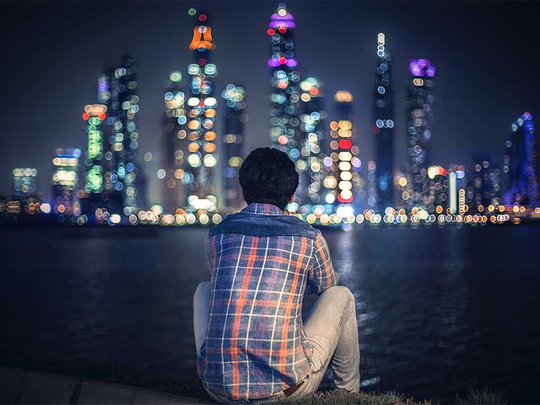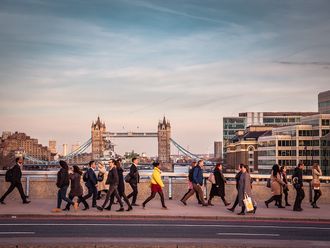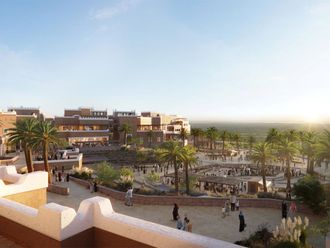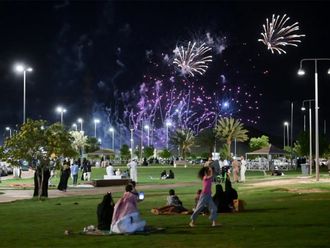
Steel giants with concrete in their veins stand tall in Dubai. Navigate the edges and you’ll see the treasures they hide. From eating your way through the city to a trip back in time, Gulf News tabloid! charts a few ways to see Dubai through the soles of your feet.
Take a stroll in old Dubai
“I used to come here and feed the cows after dinner each night,” says our guide, Vibha Talati, from Dubai by Foot. She is pointing to what is now a cafe in the Al Fahidi Historical neighbourhood, which promises the delights of juicy camel burgers.
The district has changed much since Talati first started visiting the area in 1987; it was almost demolished as part of a plan to modernise a few years later. But reportedly Prince Charles of the UK pointed to the historical significance of the area while on a trip and later, Dubai Municipality renovated the area — into cafes and stores and a glimpse into a time that was.
Walking us through the dust-coloured bylines — it’s clean, just painted in an authentic-desert hue — Talati points first to the ‘wind tunnel’ (Barajeel), or the first air conditioners, fashioned using the material available to Bedouin tribes — stone, gypsum, teak, sandal wood, fronds and palm wood. Built to maximise on wind direction and with an in-structure filtration system, these kept a house cool when the sun was being unkind, while offering some ventilation, too.
The other thing Talati points to is the shape of the houses; there is something unusual about the courtyard we are standing in. The buildings form an almost-triangle. On one wall there are three floor-length windows; on another there is one. The building that faces both homes equally, however, only seems to have a door. The Emiratis have always been a protective bunch — explains Talati, of the bars on the windows that were used to deter predators, both human and animal — and they have also always loved their privacy. So the homes were constructed in a way that nosy neighbours could be denied their favourite activity — playing peek-a-boo.
Next we trace our way to a tent — set in a typical nomadic Bedouin way, complete with the tribe’s second-favourite compatriot — the falcon, which moves its head to the sound of our feet. The first of course is the ship of the desert: the camel.
This district forms a canvas that celebrates not only art, culture, food and tradition but also various unsung heroes — murals have been made for those who serve day after day after day, some churning out countless cups of coffee, others showing people the way.
From Al Fahidi’s narrow lanes we pass into the Dubai Museum, where Talati points to an exhibit that showcases the different crafts undertaken by the people of the emirates, chief among them pearl diving. This is followed by a stroll down the ‘Hindu street’ that sees hawkers attracting potential buyers with promises of glittery clothes, peppermint and oud, reminiscent of an old bazaar.
Talati leads us further away from Al Fahidi, which this month will turn host to the annual Sikka Art Fair, from March 17-26, to undertake an activity as typical of the country as dates — abra rides. The cost of those tiny motorised taxis — Dh1 per ride — on the Dubai Creek hasn’t changed in years, we are told. And surrounded by the quiver of sea gull wings and nips of air, we cross into the Old Souk station. We walk these roads where display windows reveal chains of gold nonchalantly hanging around and our guide points out the largest gold ring in the world, at 64kg, where our tour ends in time for selfies.
It’s been an educational two hours.
Price: Dh99
Take the designer route
As Pia, our Dubai by Foot guide hops energetically from one store to the next, from gallery to factory at the Al Serkal Avenue — named for the family that founded it in 2007 — she explains the significance of the space in the context of the city. Like Dubai, it’s a storehouse of style.
Repurposed warehouses with chameleon-like qualities, these structures are playgrounds for the imagination of their owners. As long as the space is artistic, it is welcomed into the community — the method and mode of execution are inconsequential. So there’s The jamjar, which allows the young and old to create their own works of art, and there is Inked, a laboratory for chefs.
We are taken to Mirzam Chocolate, where you can see cocoa beans roasted and ground, mixed with flavours and then churned over seven days to create sweet delights. Then to The Jewel Teller where you can physically follow a piece from its conception to execution to display. There is of course the more conventional display of art through spaces such as 1x1 Gallery. And there is the ode to performing arts, The Junction.
Next, we head by car to Dubai Design Destrict, which always puts me in the mind of a hive. Its honeycomb structures are home to another set of galleries and shops — one of which stands out. The Fatima Bint Mohammad Bin Zayed Initiative provides livelihoods, health-care and a hoard to benefits to the about-3,000 Afghans employed.
Price: Dh129
Nibble into Dubai
All right, this one’s going to get ‘pun-ny’.
If you want to take a bite out of a city and really experience its flavours, the best thing to do is to walk around and nibble on the local food. And then, wash it down with tales from those who live in it.
Tapping this need of tourists and expats alike, Frying Pan Adventures serves up a table-ful of options to discover the city, a bite at a time. Our pick: the Middle Eastern Food Pilgrimage.
Atiya Fatima, who works in the administration department, says: “It’s for people who want to experience the different cultures of food. People who’ve come for a day or two [to Dubai] prefer to go for these, so they can just taste the important and main food ingredients used here.”
She said the focus on nosh is the company’s USP. They’ll explain the customs, coffee etiquette and even how to tell if your friendly neighbourhood seller is giving you a lower grade of saffron than you’d like.
Price: Dh415 (VAT isn’t included)
Picture-perfect views
The glittering skyline of Dubai is nothing if not photo-worthy, so why is it that so many of those night shots blur? The moon turns into a smudge and light crashes inelegantly into buildings it should be cascading past.
With the Shuga Photography tour, tailored to your needs, get rid of those pesky little problems and walk away understanding the techniques needed for great night photography. Things you’ll learn from a professional include the use of WB, aperture, shutter speed, and ISO, and how to make the most of your equipment.
Are you ready for a roll of great shots? Then this two-hour tour is right up your street.
Price on request.
A lesson in tradition
Stroll along with an Emirati guide as she points out the nuances of a traditional neighbourhood, and take home the lessons of the traditions and culture of the UAE.
Time 1-1.30hurs
Price: Dh250













